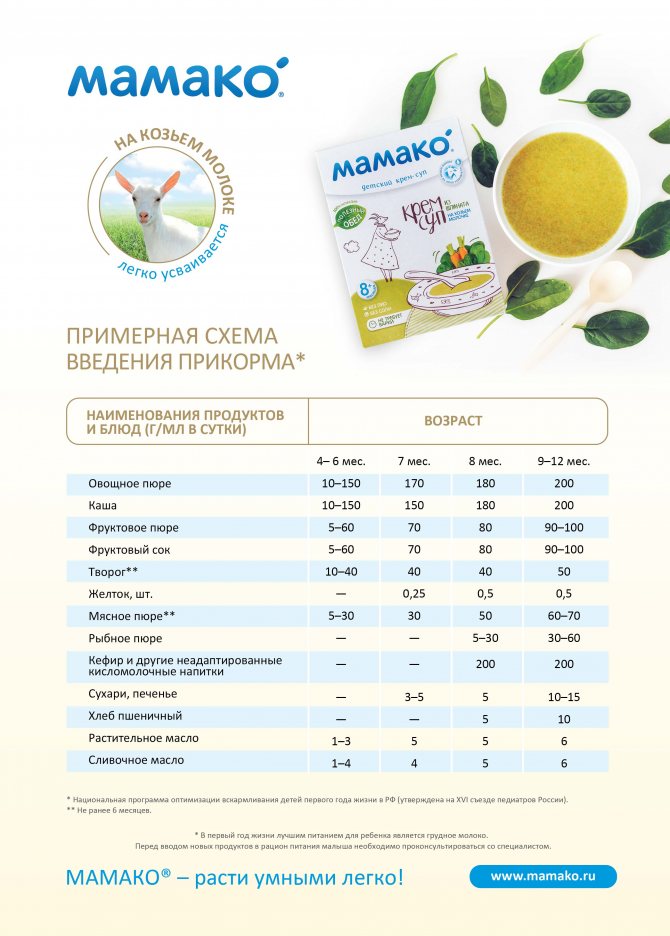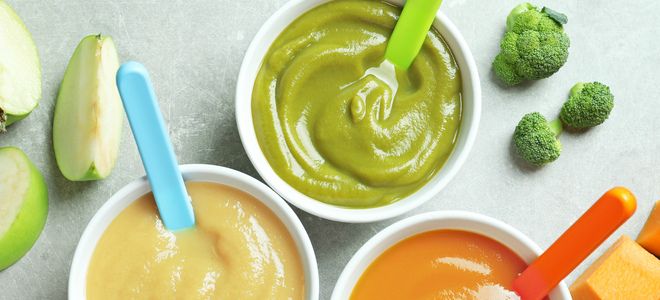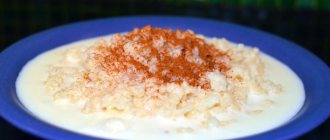Undoubtedly, mother's breast milk for a child is the most balanced, valuable nutrition, tasty and healthy product. However, over time, these beneficial nutrients for full development become insufficient, and the moment comes when the baby needs to adapt to adult life and add complementary foods.
24.11.2015 2596 16
Undoubtedly, mother's breast milk for a child is the most balanced, valuable nutrition, tasty and healthy product. However, over time, these beneficial nutrients for full development become insufficient, and the moment comes when the baby needs to adapt to adult life and add complementary foods.
Lure
This is a transitional step from breastfeeding to the common table, the introduction of additional food of plant origin into the diet of an infant up to one year. Parents should know how to provide their child with a complete, healthy diet, and how to ensure that the child himself enjoys new foods.
When is complementary feeding introduced?
The opinions of pediatricians and nutritionists differ regarding the uniform time for introducing complementary foods for all infants. Each individual case requires an individual approach. At the age of 4-6 months, the baby's teeth begin to appear, this is one of the signs that the digestive system is preparing to expand the diet.
At this time, you need to monitor the baby’s behavior, and he himself will let you know when he is ready to start trying new food. This can be determined by the following signs:
- The child often began to wake up at night from hunger because there was not enough breast milk to satisfy him.
- Shows interest in food. The baby watches with enthusiasm as his mother eats something, tries to get into the plate, and pulls food from the table.
- The baby's weight has doubled (compared to birth weight).
- At the sight of food, the child becomes excited and begins to open his mouth.
- There are attempts to sit up independently.
- The reflex to push out a foreign substance has weakened.
- The absence of colic and bloating in the tummy indicates the maturity of the digestive system.
It is worth postponing complementary feeding if your child has recently been vaccinated, so as not to put even more stress on the body.
When to introduce the first complementary foods to a baby?
Complementary feeding is any liquid or solid food that supplements the main diet of breast milk or formula. Timely introduction of complementary foods is necessary for the harmonious development of the child.
In the 21st century, there is no need for early feeding of bottle-fed babies, since modern adapted formulas contain the entire range of necessary minerals and vitamins for the baby.
Therefore, the timing of the introduction of the first complementary foods applies to both “infants” and “artificial” infants. The World Health Organization recommends the timing of introducing the first complementary foods: no later than 6 months of age, but not earlier than 4.5 months. It is much more important to pay attention to objective signs that your beloved child is ready to try a new product.
Among them:
- the baby's weight is actually 2 times the birth weight,
- after 8 or more breastfeedings/adapted formula, the baby is not averse to eating one more time,
- the baby confidently holds and turns his head from side to side,
- The baby is already sitting with support.
Porridge
The first complementary feeding usually begins with cereals. They promote the necessary weight gain and growth. Porridges are prepared from gluten-free grains - rice, buckwheat, corn. If the child does not have daily stool, then rice porridge is not suitable for the first feeding, as it strengthens loose stool, and if there are problems with it, it can contribute to constipation. For children with excess body weight, the introduction should begin with vegetable purees.
It is a mandatory rule that only a completely healthy baby can start introducing complementary foods.
Basic rules for complementary feeding
Mom should start a food diary of observations and keeping various records, where unwanted and allergenic foods will be taken into account. Complementary foods are introduced carefully, gradually, with 0.5-1 teaspoon per day
.
This volume increases little by little over 7-10 days up to 100 ml
. If a negative reaction is observed, there is no need to change the food; in this case, complementary feeding is interrupted for a while. However, breastfeeding does not change.
For better digestion, after each meal of a new food, the baby must be offered breastfeeding; you should not try to stop breastfeeding completely, especially when there is no indication for this.
Mandatory rule
Only a completely healthy baby can start introducing complementary foods.
Vaccinations, travel, change of environment, period of illness at this time you should not start adding new foods to your diet. In these cases, breast milk remains the only ideal option. The prepared food should be warm, no more than 37 C,
and is fed to the baby before the main course (mother's milk).
For safety, it is better to feed the baby using special silicone spoons. There are products with a temperature indicator, provided that if the food is hotter than the permissible norm, the color of the spoon changes. A new product is added to the diet no earlier than 7-10 days after the first, ideally when one of the breastfeedings is completely replaced.
If he doesn't want to eat, he can't force him to eat; a child knows better than his parents when he needs new food
The complementary feeding procedure for a baby should be completely safe, high-quality, comfortable, without the slightest hint of violence. Doesn't want to eat
You can’t force it; a child knows better than his parents when he needs new food.
Redness on the skin, abdominal pain, rashes
signs indicating that the product is not suitable for the baby and should be excluded from the menu. From the age of 8-10 months, food with small pieces is prepared for testing, and products of animal origin are introduced into complementary foods. It is best to consult your pediatrician about which food is best for a particular child. At this age, complementary feeding can already replace several feedings with breast milk.
Disadvantages of complementary feeding too early
- Only from mother's milk does the child receive all the substances necessary for immunity, proper nutrition and growth.
- Replacing even one dose threatens to reduce milk production, which means the number of useful components will be reduced.
- The baby's digestive system is not yet mature enough to fully digest anything other than mother's milk or formula.
But when the child is already more than six months old, he needs more nutrients to meet his growing needs, and the mother’s breast milk is no longer so rich in these components. At this age it is necessary to develop chewing reflexes. Timely introduction of products strengthens the physical and psycho-emotional health of the baby.
Gradually, feeding only with breast milk will become less and less, giving way to a variety of products. It is important to remember that the gradual introduction of complementary foods, especially before the age of 7-8 months,
does not replace breastfeeding, but only begins to complement it. According to WHO recommendations, the share of mother's milk in the diet of a one-year-old child should ideally be approximately 50-80%.
When a child reaches three to four months of age, as a rule, the mother begins to wonder if it’s time to start introducing the first complementary foods? Complementary feeding during breastfeeding is an important “milestone” in the life of every baby. However, recently, more and more pediatricians do not recommend rushing with it.
Many mothers think that feeding for the first time is not an easy task. Do not be afraid! Everything is very simple! It is important to introduce the first complementary foods correctly. So, when should you start it? From what products? In what quantity? Let's look at everything in order.
Myths about complementary feeding
There are many myths about complementary feeding. Competent experts debunk them.

The main thing when introducing complementary foods is consistency and attention to the child
Myth No. 1: Your baby will be healthier and stronger if you start complementary feeding earlier.
This is absolutely the wrong approach.
Products “inappropriate for age” can greatly harm the baby’s health and provoke the development of diseases such as intestinal dysfunction and allergies, since the baby’s digestive system may be completely unprepared to get acquainted with a new product.
It is important to be guided by the principle: do no harm!
Myth No. 2: There is enough complementary feeding for the baby; you don’t have to breastfeed
Depending on the age and needs of the baby, the composition of mother's milk changes, but it was and remains the best set of immune factors, nutrients and vitamins. For example, only from breast milk up to 2 years of age are polyunsaturated fatty acids absorbed, which promote the growth of the child’s brain and nervous system.
Myth No. 3: Home-made first foods are healthier than factory-made ones
Such dishes are equivalent only if the mother chooses the highest quality products, and porridges, ready-made purees and canned goods from reputable brands are purchased in stores. But an important advantage of “store-bought” food is that it frees up time and makes life easier for parents.
Myth No. 4: If you have low hemoglobin, it is important to supplement with apples and buckwheat porridge.
If the baby is too small for these products, then they are definitely not worth introducing. You should consult a doctor. Based on the results of the blood test, he will determine subsequent treatment, if necessary. If the baby is still feeding on breast milk, then it is important for the mother to consume more foods such as liver, buckwheat, beef and walnuts.
Myth No. 5: After a year, a baby can eat anything
Despite the fact that a baby’s diet is quite varied by the age of one, under no circumstances should you give him foods that are harmful even to any adult (sweets, fried potatoes, chips, etc.).
Children of any age should be offered only healthy food based on natural products. Be sure to have cereals, vegetables, meat and fruits. There is always a risk of getting an allergy, so it is necessary to introduce a new product gradually.
The introduction of food products is an exclusively individual process, the correctness of which can only be assessed by monitoring the growth and development of the baby.
Parents, if your baby develops in accordance with his age, is inquisitive, plays well and often does not catch colds, then this is a sure indicator that “you are on the right path, comrades”!
In order for the baby to grow strong and healthy, it is very important to choose the right first complementary foods. You will learn from the video how to balance your child’s diet and provide him with all the necessary nutrients.
When should you start your first complementary feeding?
Many mothers think that with the introduction of complementary foods they need to start weaning their baby from the breast, but this is not at all true. Complementary feeding is needed in order to begin to introduce the child to a variety of “adult” foods. The longer the child feeds on mother’s milk, the better, since it contains many useful elements that the child needs.
It must be remembered that there is no clear period for starting complementary feeding, and the baby’s readiness to eat new food is determined individually. In particular, it depends on such criteria as health status, type of feeding, child development, rate of weight gain, etc.
Most experts believe that the first complementary foods should not be introduced until the baby is six months old. By this time, the intestinal microflora is finally formed and reflexes develop that help the child swallow thick food. But this age is only approximate, because each child develops differently. The child’s readiness for the first complementary feeding is determined by a number of the following signs:
- The baby can sit independently, without the help of adults,
- Your baby shows interest in what's on your plate.
- The baby begins to latch on to the breast more often, he does not get enough breast milk,
- The baby's first teeth appear (there are already 1 or 2 teeth),
- The baby stops pushing food back and does not experience a gag reflex
- The baby's weight has doubled compared to his original birth weight.
Don't worry if your child is hesitant to try new foods. Everything will happen as usual, there is no need to force or try to forcefully introduce complementary foods. The baby must “come” to this himself.
Where to start the first complementary feeding?
Disputes about where to start complementary foods first are still ongoing among pediatricians. Some are of the opinion that the best start for a baby’s new diet is porridge, while others, in turn, insist on special children’s curds and kefir.
However, there is one clear rule that all experts agree with - it is strictly forbidden to start the first complementary feeding with juices. They are difficult to digest food and can cause allergies in the baby. Juices from stores contain large amounts of sugar.
Despite all the discussions, the best ways to complementary foods are both cereals and vegetables. Where exactly to start depends on some physiological factors.
For babies who have had trouble gaining weight, it is especially recommended to eat dairy-free and gluten-free foods.
porridge - they do not contain proteins that are complex and difficult to digest. Therefore, do not even think about giving your child semolina, oatmeal or pearl barley - he simply will not be able to digest it, which will lead to digestive problems.
Babies who have been gaining weight by leaps and bounds can start their first complementary foods with vegetable or fruit purees. Under no circumstances should you add salt or sugar to the puree; your baby is not yet able to perceive such taste characteristics. It is much easier for him to taste the “pure” taste of the products themselves, since his taste buds are still developing and are very different from those of an adult. It is better to choose for puree those vegetables and fruits that you yourself love and that you most often consumed during pregnancy, since during uterine development the baby has managed to develop a tolerance to one or another vegetable or fruit.
How to give complementary foods correctly?
What you need to remember first of all is that complementary foods need to be introduced gradually. New products become only an addition to the main diet - breast milk.
- New food should be given in small portions, it is recommended to start with half a teaspoon, increasing the dose every day,
- Start with purees and cereals containing one product,
- There is no need to force your child to finish eating if he does not want to,
- Do not insist on this or that product if the child does not accept it.
The point of complementary feeding is to introduce the child to new foods and new tastes. Don't try to stop breastfeeding. It is also recommended to offer the baby the breast after each complementary feeding so that the new food is better absorbed.
During the feeding process, the following problems may appear:
- The child refuses to try the product offered,
- Problems have arisen in the gastrointestinal tract (GIT),
- An allergy appeared.
In such cases, you need to determine which product caused such a reaction and eliminate it from the diet.
First complementary foods while breastfeeding
Is your child very interested in food and loves to sit at the table? These are signs that he is ready to start complementary feeding. When and what foods to give as the first complementary foods when breastfeeding, so that the baby enjoys eating, says nutritionist, member of RoSNDP Anastasia Ivanovna Shalunova (and in addition, you will learn about the nutrition plan for children under 12 months). Don't worry: introducing complementary foods does not mean giving up breast milk. You can still breastfeed your baby for as long as you both want.
— Anastasia Ivanovna, what is called complementary feeding and is it possible to combine complementary feeding and breastfeeding?
— Complementary feeding is everything that is not mother’s milk or formula. Complementary feeding can be combined with breastfeeding, but it is important to consider the age of the child. It is better to start complementary feeding when food interest is formed (the child looks into his mother’s mouth, grabs a spoon with his hand, and is interested in the contents of the plate).
— When to introduce the first complementary foods when breastfeeding and what to give the baby for the first complementary foods?
- Everything is individual. When introducing solid food, mothers are conditionally guided by the complementary feeding calendar, which is recommended by pediatricians. It is also important to adequately perceive the situation in which the child is - complementary feeding can be started if the baby feels well
(no fever, constipation, diarrhea, etc.). In addition, it is not advisable to give complementary foods before or after vaccination.
Scheme of the first complementary feeding during breastfeeding

— How to understand that the baby is ready for the first feeding? Do I need to prepare my child for the introduction of new food?
— There is no universal way. You need to understand whether the child is hungry or not, and monitor his food interest. If you just start complementary feeding, it may not “take off”, since food interest in adult food is formed from 4 to 8 months. It is during this period that the child has the need to try a new product. And in order to interest him, parents must show by personal example how and what they eat.
— They say that a child can be given a teaspoon with some water. And if he begins to react in a special way, it means he is ready for complementary feeding.
- You need to watch how the child behaves with a spoon - plays or repeats the mother’s actions while eating. Initially, we can talk about the first pedagogical complementary feeding - the mother eats, and the child is nearby in an upright position and repeats her actions. Closer to six months, the spoon may contain the complementary food product itself (the child is given a spoon with food, and he repeats what the mother does).
Rules for the first complementary feeding when breastfeeding: what parents should and should not do
- The child must be hungry: first, complementary foods are given, then breastfeeding occurs.
- Complementary feeding begins with once a day.
- During the first feeding, one new product is introduced in the amount of half a teaspoon, then the portion is gradually increased.
- The next new product is introduced no earlier than 4-5 days after the previous one, in order to track the body’s reaction.
- During feeding, the baby is in a sitting position.
- You should not give complementary foods when the child is restless or psychologically unprepared for unfamiliar food. During a stressful situation (moving, vaccination), the child may not like the product and the child may not accept it.
Incorrectly introduced first complementary foods will affect the child's health. The functions of the gastrointestinal tract will be disrupted, which will manifest itself in the baby’s behavior or in the form of digestive disorders (diarrhea, constipation). Consequently, you will be forced to cancel the product with which you started complementary feeding and look for other options.
— Is it possible to give juices to a breastfed baby as complementary food?
— Despite the early age recommendations on the labels, neonatologists and nutritionists do not recommend starting the first complementary feeding with juices because they are sweet. The child’s taste buds will be distorted, and after drinking sweet juices, he may not want to eat bland vegetable purees or cereals.
First foods for breastfed babies
| For children who are underweight: gluten-free one-ingredient porridges - rice, corn, buckwheat. | Children of normal weight who are prone to constipation: vegetable purees - all types of cabbage, potatoes, zucchini; later - green peas, pumpkin, apple. |
Porridge preparation option:
| Option for preparing vegetable puree:
|
— Anastasia Ivanovna, is it true that a child will not eat vegetable purees after fruit purees? In what order is it better to give permitted foods?
- All babies are different. But most often, after sweet fruits, children are reluctant to eat bland foods. Therefore, the first feeding of a breastfed baby often begins with vegetable puree or porridge. Later, you can try fruits in the form of juices or fruit purees, for example, with cottage cheese. Some pediatricians recommend adding yolk, but I would leave it for complementary feeding from seven months
, because the enzymatic system in a small child has not yet been formed and undesirable reactions may occur - allergic or from the gastrointestinal tract.
Then ground meat purees (not lumps) are introduced, and fish purees are introduced closer to eight months
. According to the standards, fermented milk products are given from the age of seven months, but I recommend introducing all dairy products into the baby’s diet closer to one year. Not all children are physically ready to consume them due to the acidity and mineral salts. Then - crackers, bread, vegetable and butter. Any product is administered in small spoons with a gradual increase in portions.
— How to properly offer a child his first new food and what to do if he refuses it?
— Complementary feeding can be offered in a playful way, but it is better not to play around so that the child has a clear picture: he sat down to eat in order to satisfy his hunger. It’s good to sit at the table with the whole family so that the baby understands that at certain moments the family gets together and eats together. There is no need to persuade: if he wants, he eats, if he doesn’t want, he doesn’t eat.
With such persuasion as “eat a spoon for mom, for dad, for grandma, for grandpa,” the child may refuse to eat altogether. Let's try different foods at certain ages. And, of course, the mother needs to be mentally prepared for the fact that the same product will have to be given to the child in several versions if he initially refused the food offered.
— Is it possible to give a child complementary foods from jars or is it necessary to prepare purees at home?
— Companies that specifically deal with baby food have all the necessary facilities and preparation conditions, as well as fresh products. From one jar to another, the puree will have the same composition and taste. If you cook at home, you can’t track either the quality of the product or the temperature (overcooked today, undercooked tomorrow). All this will affect the child. Of course, if you have organic vegetables grown in your own garden, mom can cook the puree herself. But in reality, we are all limited in time, and it is difficult to cook constantly at home.
Jars are more convenient, especially if you need to go somewhere with your baby or go to the clinic. When choosing a puree, carefully study its composition. MAMAKO® goat milk baby purees are excellent for complementary feeding of breastfed children. Such purees are balanced in nutritional value, the amount of nutrients and are superior to the homemade version. In addition, they are packaged and stored without dyes or preservatives. Cotton when opening the vacuum packaging is proof that all stages and requirements for the quality of the product were met during production.
Complementary feeding is anything other than breast milk or infant formula. Complementary feeding begins when the baby is healthy and psychologically ready to accept a new product. But don’t panic if you started complementary feeding not at four months, but closer to five months: each child is unique and has his own preferences. As to what foods are allowed or prohibited for the first complementary feeding, you should follow the recommendations of pediatricians. Do not rush to give all the products at once - start with one, and with half a teaspoon once a day, gradually adding a portion. Manufacturers of canned food guarantee its quality, but you need to monitor expiration dates and focus on your perception if there is something you don’t like about the product.
Nutritionist Anastasia Ivanovna Shalunova
*The ideal food for an infant is mother's milk. WHO recommends exclusive breastfeeding for the first 6 months. MAMAKO® supports this recommendation. Before introducing new foods into your baby’s diet, consult a specialist.
When should you start introducing new foods to your complementary feeding menu?
In other words, during the first 14 days you need to give your baby the same puree so that he has time to get used to this product. And only then do you introduce a new puree from another fruit or vegetable, or porridge.
This is how you gradually add fruits and vegetables to your child's diet. There is no need to rush to accustom him to a variety of foods. Do not forget that you need to ensure that this or that product does not cause an allergic reaction or problems in the gastrointestinal tract.
Do not forget to monitor the expiration date and condition of the products, and do not store open boxes of cereal for a long time. So, they very quickly lose their beneficial properties.
In addition to introducing new foods to your child’s diet, you also need to show him cutlery. It is advisable to buy a special set (spoon and fork) for babies. In about a month, the child will be able to eat on his own using the necessary equipment.
That's all! Nothing complicated!
When?
Complementary feeding is introduced no earlier than the baby turns 5.5 months (preferably at 6 months). At this time, the amount of nutrients in breast milk decreases somewhat, and the baby has already grown enough to try new foods.
However, continuing breastfeeding is not only possible, but also necessary. Certain processes occur in your body, and the composition of breast milk changes, adapting to the needs of an older baby. Mother's milk for a child over 6 months old is an endless source of vitamins, microelements, proteins, important hormones and enzymes. Complementary feeding becomes like an energy supplement to your milk, but not a substitute for it. Breastfeeding is still very important for your baby emotionally: at the breast he calms down faster, falls asleep, and feels more protected.
Before making a decision to introduce your baby to new tastes, you need to pay attention to his well-being: the child must be completely healthy, gain weight well and not experience stress associated, for example, with moving or climate change. Make sure that the start of complementary feeding does not coincide with vaccination periods. And, of course, you need to get recommendations from a pediatrician! Indirect signs that the child is ready for the introduction of complementary foods are: the appearance of teeth, increased appetite, manifested in frequent demands for the breast and lack of saturation with mother’s milk.
How?
Complementary foods should be introduced gradually. Start with a teaspoon (5 ml), gradually increasing the volume day by day (2 weeks after starting complementary feeding, the portion will be about 50 ml). As a rule, children's juices and fruit purees are used as the first complementary foods: apple, pear, carrot, plum. Then porridges are introduced: rice, corn, buckwheat. Cottage cheese and other dairy products are usually introduced from 7 months. For your convenience, we have collected recipes for babies from 6 months in a special section “Baby Menu”.
To make it easier for the baby to adapt to complementary feeding, at the first stage you can add a small amount of breast milk to the puree - then the baby will smell a familiar smell and be more willing to eat what is offered. Introduce any new foods into your child’s diet one at a time - this way you can track an allergic reaction. If everything is fine, you can gradually increase the dose of complementary foods (1.5-2 times a day), but if something is wrong, the product should be put aside for a while.
How to prepare the first complementary food?
Many mothers prefer to buy ready-made purees, but preparing a baby’s first complementary food is not as difficult as it might seem. The main thing is to choose fresh vegetables or fruits and rinse them, preferably with purified water. For the first time, you should try to treat your baby to vegetables without coarse fiber - carrots, zucchini, cauliflower.
Cooking tips:
- It is safer to cook vegetables in a double boiler; they dry out quickly in the microwave.
- When cooking, food is placed in boiling water.
- Frozen fruits or vegetables should not be thawed in advance.
- It is recommended to bake fruits.
Porridge for first feeding
Doctors recommend choosing dairy-free cereals for the first complementary feeding, and only low-allergenic cereals. These include buckwheat, rice and corn, the latter is considered the hardest for a child, so it is better to stick with buckwheat. Rice must be washed several times to remove starch. If your baby has frequent constipation, it is not recommended to feed rice porridge, as this will worsen problems with stool.
How to cook porridge for first feeding:
- Grind the cereal into flour, pour boiling water over it and leave to swell.
- At first, prepare a thin porridge by diluting 1 teaspoon of cereal flour with 100 ml of water. After a couple of weeks, 2 teaspoons are added.
- Before serving, you can add a little breast milk or ready-made formula; add oil only a month after the first feeding.
Vegetables for first feeding

When adding vegetables to complementary foods, other rules should be taken into account. The main thing is not the amount of food, but its variety; you can distribute a little zucchini and carrots into the allotted 100 g of puree, provided that the child is already accustomed to these vegetables. For the first month of eating, the vegetable puree is not seasoned with anything, then the oils begin to be added drop by drop.
Tips for preparing vegetables for complementary feeding:
- Vegetables need to be rubbed through a sieve or chopped in a blender; a masher does not mash the fibers.
- There is no need to add salt to the puree; you can add a little vegetable broth or ready-made mixture.
- Potatoes for a baby are a heavy dish; they should not be prepared on the list of first courses.
- Until one year of age, babies should not be given white cabbage, beets, tomatoes, cucumbers and greens; they are more harmful to the stomach.
Fruits for first feeding
Doctors recommend starting baby's first fruit feeding with green apples and ripe pears. Renet Simirenka or Antonovka are best suited; they retain moderate acidity. The fruits need to be peeled; they are too hard for a child’s stomach. If the apples are very sour, baking will help remove the strong taste.
What you need to know about introducing fruit into complementary foods:
- After the apples, it is recommended to try a banana; due to its fiber, it is crushed very carefully.
- Berries can cause intestinal upset; they are high in fiber. It is believed that the optimal portion of berries is how many a baby can hold in a handful.
- Apples and pears can be given fresh, grated or baked.









